On a dusty road through a small Maya village that time forgot sits one of the crossroads of the Maya, Coba, the Maya roads of home. The once great Maya City, Coba, named for the twin lagoons bursting with reeds nearby is still a relic of the past, predominantly unrestored, yet partially cleared of the foliage and centuries of settlement that covered the landscape and its hidden architecture. The ancient city is combed with roads called “sacbe”, stone paths, that linked other Maya villages and trading centers as far away (55 miles+-) as the great Maya center at Chichen Itza. Estimates by archeologists indicate that at one time Coba was home to upwards of 50,000- 100,000 Maya indicating that the city was a major kingdom in the Maya Classical Period some fifteen centuries ago, dominating the region for a period of at least four hundred years from the 5th through 9th century.

The view from atop the pyramid Nohoch Mul at Coba (Courtesy of Wiki)
It was on an early morning from Cancun we set out to visit the Maya ruins at Coba, a bright, clear and warm day awaited us as our amigo Javier came by the Hotel to pick us up. Javier is a frequent traveler with us on our Yucatan excursions, sharing our experiences and providing us with savvy advice as we negotiate the region, often a guide and always a friend, we rely on Javier’s expertise whenever possible as our amateur adventure team continually explores the Yucatan. We headed out on highway 307, the road to Tulum and coastal route that parallels the Caribbean in the Mexican State of Quintana Roo, passing Puerto Morelos, Playa Del Carmen, Puerto Adventuras and a host of small villages developed in recent years as the Riviera Maya continues to grow.
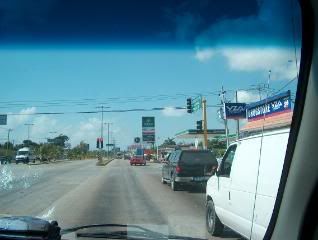
The Coastal Highway 307
We made a couple of stops, one for provisions in a small outpost outside Playa and yet another for my better half when the “Jewelry Factory” suddenly appeared with the promise of sparkling gems and clean bathrooms on route. Along the way we passed three security checkpoints that reminded me of U.S. style speed traps except these featured local police drinking cokes and eating tortillas instead of coffee and donuts. We were so stricken with fear from the coke drinking officers packing automatic rifles hanging over their backs that we shared a smoke and joked about the weather briefly as traffic slowed next to them.

The Jewelry Factory
After a short traffic delay we were on our way, moving off the coastal road and onto the road to Coba, a road with scattered cottages and palapa homes checkering the tropical forest roadway. Entering the town of Coba we found a small village of rustic design that we’ve found common off the beaten path of the Yucatan, a quaint house of worship that proved once again that people and God don’t need fancy buildings to believe, a police station with two officers sitting on the steps, sipping soda in the late morning sun, and numerous mom and pop style shops serving cold drinks and local foods, most with just an old Coke ice chest as a cooler and a block grill for cooking. The town was amazingly laid back, serene, a fine counterpoint to the bustling tourist areas of the coastal areas.

The Iglesia of the town Coba (Church)
A short while later we entered the Maya City of Coba, greeted by the entrance guard shack and populated by a series of small trinket shops, clean restrooms and small open air style cantinas catering to visitors surrounded by the tropical forest and the hidden ancient city. One could almost feel the history lurking beyond, an almost ominous presence existed from the past beckoning one onto the dusty paths that led into the tropical forest. As we entered, one is greeted by directional signs and bicycle taxis, small two seat contraptions that are pushed by a bike driver as a means of conveyance over the vast paths in and around the ruins of the city.
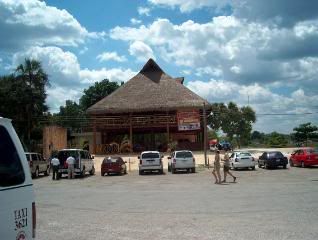

The entrance and shop area of the Coba Ruins
We spent the day visiting and wandering the site, climbing some of the available ruins (not all that are available are publicly accessible, most are) venturing up the Nohoch Mul pyramid, the tallest in the Yucatan, amazed at the ancient ball courts, the church, the observatory, various temples and cultural buildings while never shaking that sense that something was still alive from the past here.
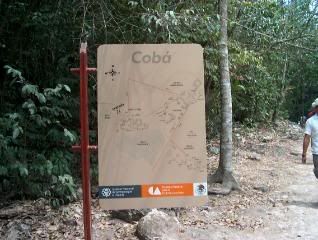

Entrance Sign and the Pyramid Nohoch Mul
By alive from the past, I’m referring to that human sixth sense that lets you know that something happened here, more than just the rise and fall of a once powerful city state, a window of the past that still has a story to be told, a feeling beyond the sterilty of today’s Chichen Itza, though on slow days Chichen has the feel of history especially Old Chichen, or the poorly excavated and restored Tulum, this was something else, call it the ghosts of Coba, there’s still history to be told here amongst the ebb and flow of Coba’s unexcavated ruins, not unlike the feel one gets from visiting places where great battles have taken place.
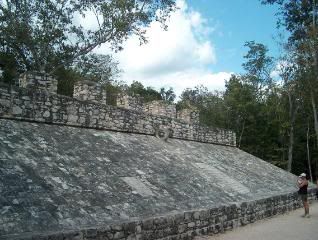
Ballcourt #2
The roads and paths that intersect and twist out of the city indicate that Coba was a central crossroads city state of high importance to the Maya, a prominent place of power and with its large natural water reserves from the two nearby lagoons, the eyes of Coba, a likely place of conflict over the years. Over the course of at least four hundred years the Maya civilization at Coba had risen and fallen, disappeared into the past until the 1920’s though reports indicate that scholars had known of her for almost fifty years prior. It wasn’t however until the later part of the 1900’s, spurred by advancing tourism that extensive excavations began at Coba and the city of the Maya would once again awaken.
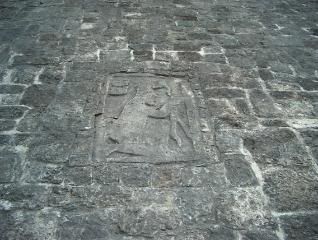
Large stelae at ballcourt
Coba is somewhat unique among other popular Maya sites in that many of the building sites within the forest are largely unexcavated including the large pyramid. Climbing the main pyramid on a hot day is a chore unto itself but worth the effort, just be aware that the climb is steep, uneven and not for those inclined to vertigo.
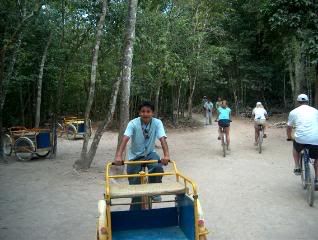
Bicycle Taxi: 100 Pesos
Coba is recommended by us and the journey from Cancun will take about two plus hours depending on traffic and stops along the way on the 110 mile or so journey. The site is open 8-5 and a small admission is charged, bicycle taxis are available for rent and are also recommended. The site includes a small tourist center, shops and restaurants, most with prices that are reasonable for typical similar attractions. The staff and people working on site are friendly and safety concerns are primarily from the health side as the tropical forest by definition is hot, humid and damp. Bring a good “Deet” based insect repellent and hydrate yourself as necessary. There’s also a beverage and snack stand located approximately half way into the park.
Nya b’a’n tu’n tjax tk’on chi’l toj twiy, ku’n b’e’x ch’ajila tu’n tx’yan.
[He who walks without looking will fall into trouble; non literal translation]
Dangers…























